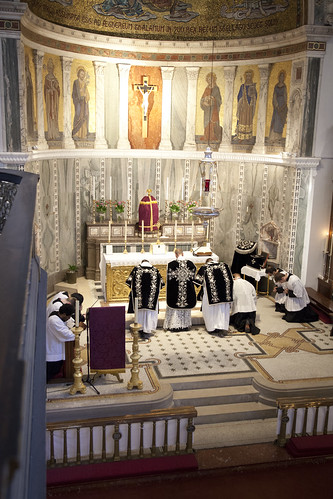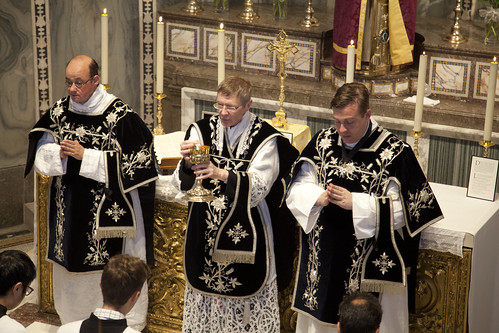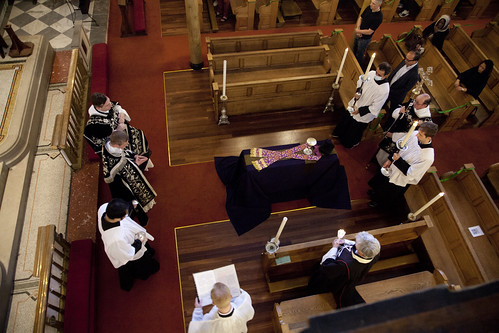Chairman's Blog
Requiem for Fr Anthony Conlon
 |
| As a priest, the catafalque (coffin stand with pall, representing the body) has a chalice and paten, and biretta, on it. |
It was accompanied by the Cantores Missae under the direction of Charles Finch. They sang the Missa Defunctis of Giovanni Francesco Anerio (1567-1630), for four voices. This setting is unusual in including the Dies Irae, which can otherwise be sung to the chant setting: Anerio's setting alternates chant and polyphony line by line. The Cantores Missae also sang Anerio's setting of the Libera me, the moving chant which precedes the blessing of the catafalque: his polyphonic setting is superb, and not often sung because of its length.

Warwick Street has a regular Wednesday evening Sung Mass (6:30pm), usually accompanied by chant.
We will not fail to remember them--as St Monica urged her son St Augustine to do--at the Altar.
Concelebration: a new front in the liturgy wars?
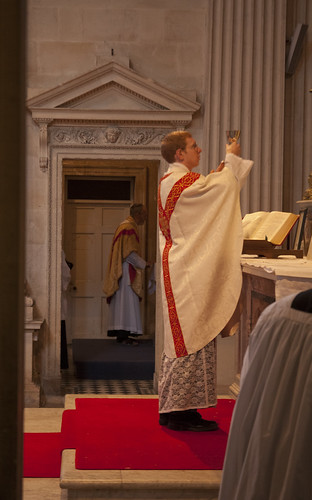 |
| Individual Masses at the LMS Priest Training Conference in Prior Park a few years ago. |
The celebration of priests together, when two or more priests celebrate one Mass, has long caused controversy. For decades after the Second Vatican Council priests have felt under pressure to take part in “concelebrated” Masses instead of celebrating their own Mass, perhaps without a congregation. Concelebration is now being enforced in St Peter’s Basilica in Rome, ending the long tradition of large numbers of priests celebrating individually at side altars. Now concelebration is being used as a weapon against priests who celebrate the Traditional Latin Mass: the Archbishop of Dijon, Roland Minerath, is ending the 23-year-old apostolate of the Fraternity of St Peter in the Archdiocese because the priests serving it prefer not to concelebrate.
Many bishops, religious superiors and seminary rectors like concelebration, as it gives them effective power over the celebration of Mass by their priest subordinates. They can insist that these priests not only attend a “conventual” or “community” Mass when priests are gathered together, but do so in a way which prevents them from celebrating a Mass of their own. When there is a large number of priests, most of them have hardly anything to do in concelebration, and of course they have no control over it: they can’t celebrate it at an earlier or later time, in a chapel with special significance to them, or using liturgical options of their choice, such as a votive Mass. Concelebration is a control-freak’s dream.
Who is afraid of the Traditional Mass?
My latest on LifeSite.
On Sunday July 3, the FIUV — the International Una Voce Federation — took out an advert in the Rome edition of the Italian newspaper La Repubblica, to make a statement about the Traditional Latin Mass. It points out:
“The growth of interest in the traditional liturgy is not due to nostalgia for a time we do not remember, or a desire for rigidity: it is rather a matter of opening ourselves to the value of something that for most of us is new, and inspires hope.”
That it is controversial to be attached to the liturgy used by the Church for more than a dozen centuries is the sign of a deep malaise in the Church. Two prominent prelates in the Roman Curia have recently been reported making remarks about the Extraordinary Form (EF) of extraordinary hostility, and these have come after weeks of speculation about a new official document which will in some way roll back the freedom which Pope Benedict XVI gave to the more ancient liturgy in 2007.Possibly all these stories and rumors are false or taken out of context — the Vatican can seem like a hall of mirrors sometimes — but the mere fact that these stories are circulating is a reminder that the Old Mass has determined enemies in Rome.
Read it all there.
Support the Latin Mass Society
Statement from the FIUV
The Una Voce Federation has taken out an advert in the mass-circulation Italian daily newspaper La Repubblica, appearing today Sunday 4th July.
The English text is as following (for other languages see here):
The International Federation Una Voce (FIUV), founded in 1965, brings together associations of the lay faithful attached to the Extraordinary Form of the Roman rite (the Traditional Latin Mass).
In 2007, the Apostolic Letter Summorum Pontificum recognised the vitality of the traditional liturgy, the freedom of priests to celebrate it, and of the faithful to request it. This has led to an ongoing increase in the number of celebrations of the ancient Latin Mass, and of its spiritual fruits.
During 2020 the FIUV conducted a worldwide survey of the faithful on the implementation of Summorum Pontificum. From this survey, which included results from 364 dioceses in 52 countries, we found:
• The ancient Latin Mass is deeply appreciated by groups of faithful of all ages, especially families with children, young people and converts, found in all social and cultural environments, on all continents and in an ever increasing number of countries.
• In many areas the increased availability of this Mass has favoured the normalisation of relations between the faithful attached to it and their bishops, relations increasingly characterised by mutual understanding and respect.
Nevertheless, we have noticed that, contrary to the previous policy of the Holy See, there are still people within the Church, including some bishops, who would like to see the Extraordinary Form of the Roman rite explicitly suppressed, or subject to further restrictions. For this reason, the FIUV, in view of the faithful who adhere to the Latin Mass, feels the duty to express its opinion, encouraged by Pope Francis' exhortations to the members of the Church to use parrhesia with the necessary humility.
The growth of interest in the traditional liturgy is not due to nostalgia for a time we do not remember, or a desire for rigidity: it is rather a matter of opening ourselves to the value of something that for most of us is new, and inspires hope. Pope Francis has characterised the ancient liturgy in terms of a "sense of adoration" (Press conference of 28 July 2013), we can also apply his words to it: a "living history that welcomes us and pushes us forward" (Evangelii Gaudium 13).
Today we only wish to be part of that "great orchestra" of "unity in variety" which, as Pope Francis said (General Audience of 9 October 2013), reflects the true catholicity of the Church. The Apostolic Letter Summorum Pontificum continues to transform the conflicts of the past into harmony: long may it to continue to do so.
Felipe Alanis Suarez, President www.fiuv.org
Ends
Some details from the international survey are set out in here.
Child sex-abuse: blaming the victims
 |
| Who will do reparation for the crimes our society so casually sweeps under the carpet? LMS Mass of Reparation for Abortion, Bedford |
...while the official message is that everyone has the right to say “no”, saying “no” is the mark of being uncool or actually a bad person. Schools have handed potential rapists a new and powerful arsenal of psychological techniques they can use to put pressure on their victims.
Of course, few teachers believe this message themselves: in its implications, it is an extreme form of sexual libertinism incompatible with long-term relationships and family life. What they actually think of the child-victims of the intense social pressure to agree to sexual acts is revealing. One testimony on Everyone’s Invited described how when boys shared nude photos of the girls with each other, it was the girls who were blamed from creating the images in the first place, at the insistence of their boyfriends.
The Strange Survival of Conservative Christianity
Just over two years ago, Daryush Valizadeh—better known as known as ‘Roosh,’ the ‘pick-up artist,’ and enemy of feminism, who had slept with thousands of women and written ‘how-to’ books so other men could emulate this achievement—announced that he was reverting to the Armenian Orthodox faith of his upbringing. He renounced his past life, publicly repented his sins, and ‘unpublished’ most of his books. Many of them had been banned from Amazon anyway; you could only buy them directly from his website.
More recently, Milo Yiannopoulos, the gay alt-right provocateur who had tried—with varying success—to build a career from generating outrage, reverted to the Catholic faith of his own upbringing, declaring himself ‘ex-gay’ and ‘sodomy-free’ to the conservative Catholic website LifeSiteNews.
It is fair to assume that none of these four men have much interest in liberal Christianity. It is towards the beleaguered Helm’s Deep of conservative or traditional Christianity that they are heading. The embattled garrison may well have mixed feelings as this particular contingent of reinforcements crest on the horizon, but as their worst enemies would, perhaps, agree, they do need Jesus.These two individuals are—or (in their previous personae) were—among the most toxic and hated figures on the planet for feminists and others on the social-justice bandwagon. In a somewhat different category, though still heartily loathed by the woke Left, are Jordan Peterson and Laurence Fox. It seems increasingly possible that Peterson, a Canadian clinical psychologist who has won fame as a life-style guru, is moving towards belief in—and not just respect for—the Christian religion. The divorced actor-turned-campaigner Fox, in turn, who had been ‘cancelled’ for claiming that Britain is not a racist country, has revealed that he has become more ‘outwardly Christian,’ and says prayers with his sons every night.
The 'Managed Zone' of prostitution in Leeds closes
Since 2014, the local police and city government have allowed a slab of the city of Leeds in England to become a crime-ridden nightmare, in the forlorn hope that other parts of the city would benefit. This bizarre policy has finally been scrapped.
The U.K.’s laws against prostitution are far from satisfactory, but they do exist. It is illegal to solicit for paid sex, and this includes what is known as “curb crawling.” It is also illegal to “live off immoral earnings”, which outlaws brothels. The city council and the police of Leeds announced that these laws would not be enforced in a certain mainly non-residential area of the city between 8pm and 6am. The area was nevertheless heavily monitored — or so it was claimed — and the scheme cost the city and police around £300,000. It should have come as no surprise that the designated area, and increasingly areas around its borders, became a kind of enterprise zone for criminals engaging in rape, sex trafficking, drugs, and even murder. I hesitate to reproduce descriptions of what it was like, but a lot of physical cleaning-up had to be undertaken every morning at the city’s expense, the problems continued 24-hours a day, and people who lived nearby were far from happy.
Liturgy, Abortion, Doctrine: entwined crises
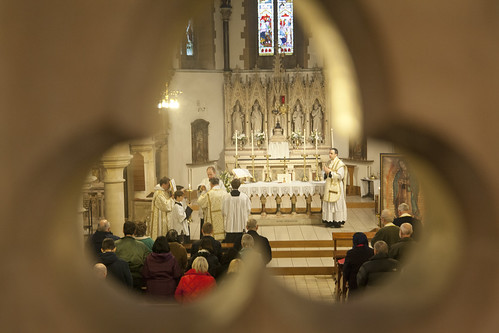 |
| Latin Mass Society's annual Mass in Reparation for Abortion, at the Shrine of Our Lady of Guadalupe in Bedford, 2019. |
The liturgy is the holiest possession of the Church: it contains God’s very presence, and those things most intimately associated with that. It is the frame for the familiar ways we engage with that presence, in the intimacy of our souls. What progressives were claiming, and continue to claim, is that the Church had got the liturgy seriously wrong, and had done so for more than a thousand years.
This message destroyed the faith of many Catholics, including many priests and religious. It was resisted by others, and this created a bitter internal conflict in the Church which is still continuing. For many Catholics who were not especially well-informed or ideologically committed, it simply caused confusion. Above all, for those inside and outside the Church, it did the opposite of what the Vatican II reforms were supposed to do. Instead of sending the Church on a renewed mission with greater confidence, it filled her children with self-doubt and made the Church look, to outsiders, disunited and unsure of herself.
Do Traditional Catholics deserve a good kicking? A reply to M.W. Davis
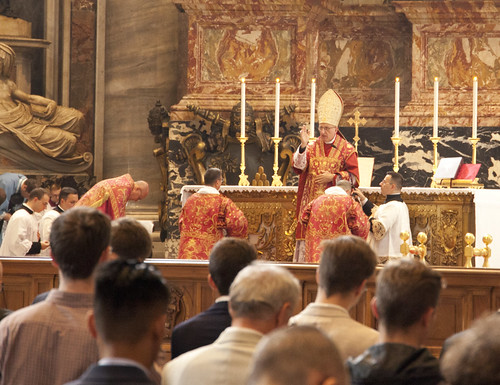 |
| Bishop Rey of Frejus (France) celebrating the EF in the Chapel of the Throne in it Peter's Basilica, Rome |
Michael Warren Davis has, again, attackedCatholics attached to the Church’s traditional Latin liturgy. His repeated, embittered criticisms of this particular group within the Church (see hereand here) are invariably motivated by a deep fraternal charity—so he tells us, anyway. The headline writer at the American Conservative, trying perhaps to discern exactly what the point of Davis’ article might be, subtitles it ‘Do liturgical dissenters deserve whatever sanctions the Vatican is preparing? Do they need them?’ The confusion between the two questions permeates the article. How are we to understand possible restrictions on the celebration of the Traditional Mass as something which is going to help the situation Davis describes? The maxim ‘Beatings will continue until morale improves’ comes to mind.
Davis shows that many Traditional Catholics (he refers to Michael Matt, Jeffry Tucker and Bishop Fellay of the SSPX) extended to Pope Francis much good will when he was first elected—as was only right, one might think. Then, he says, Traditionalists turned on the Pope, citing George Neumayr, Henry Sire, and Archbishop Vigano. But are the members of this second trio ‘Traditional Catholics’? If ‘Traditional Catholics’ are those with some discernible long-term commitment to the Traditional Mass, the answer is ‘no’.
Davis could have come up with different names, perhaps, but this mistake illustrates a problem with his analysis. At one point he says ‘ “traditionalism” these days is defined as much by its hostility towards Pope Francis as it is by love of the Latin Mass’. The way Davis takes this is that Catholics who criticise Pope Francis must be Traditionalists for that very reason, not the other way round. The great thing about circular arguments is that once you are inside one, no evidence can convince you that you are wrong.
The truth is more interesting. The most significant resistance to Pope Francis has come not from people associated with the Traditional Mass, but ‘conservative’ Novus Ordo Catholics. To the names just mentioned one could add the late Prof German Grisez, the Franciscan theologian Fr Thomas Weinandy, and Cardinal George Pell. Archbishop Vigano would never have risen to the position of Nuncio to the United States, nor could Fr Weinandy conceivably have become theological advisor to the US bishops, if they had been traditionalists. Pell is friendly to the Traditional Mass, it is true, but hardly a proponent of it. Not only have their positions given these men standing in the debates which have flared up during the present pontificate, but like many establishment conservative Catholics they have felt particularly motivated to react to Pope Francis’ demolition of the legacy of Pope John Paul II, a legacy with which conservative, as opposed to traditional, Catholics, tend to identify very strongly.
In this context, were Pope Francis to react to criticisms by placing restrictions on the Traditional Mass, this would seem a bit beside the point. Certainly, Traditional Catholics have often supported such criticisms, and made their own, but they are by no means the root of the problem from Pope Francis’ point of view. Indeed, given the tiny numbers and utterly insignificant public profile of Catholics attached to the Traditional Mass, I would say that their contribution to public debates in any particular direction must be almost completely irrelevant to the balance of forces in the Curia.
It is not clear, indeed, what impression, if any, Pope Francis has of Catholics attached to the Traditional Mass. Davis quotes Pope Francis talking about
‘certain “neo-Pelagians” who “feel superior to others because they observe certain rules or remain intransigently faithful to a particular Catholic style”—an obvious swipe at traditionalists’
Is this an ‘obvious swipe at traditionalists’? Perhaps Davis is unaware of Cardinal Ratzinger’s critique of the Novus Ordo collects as ‘Pelagian’, but he must realise that Pope Francis’ ‘rigid’ stereotype came with him from Argentina. It presumably derives from his experiences of hyper-conservative Catholic groups there, of which there are many; his main experience of Traditionalists before he became Pope was, after all, with the SSPX, with whom, as Davis himself says, he had surprisingly good relations. Certainly the ‘rigid’ stereotype would fit better the Novus Ordo-oriented Legionaires of Christ and some of the ‘New Movements’ than the Traditionalist Fraternity of St Peter, or the lay Una Voce movement.
Pope Francis, it is true, has applied the stereotype to traditionally-minded seminarians when prompted by interviewers, but it is clear on those occasions that he is looking for an explanation for the phenomenon, and reaches for one familiar to him. The idea that he has been influenced by English-language social media (‘bear in mind that Westerners’ experience of everything is mediated by the Almighty Screen’, Davis tells us solemnly) is simply ludicrous.
If Pope Francis is preparing some kind of slap-down for the Traditional Mass, it is not difficult to understand why this might be. He has been under consistent pressure to do something of the kind from influential bishops since becoming Pope, and has equally consistently resisted this pressure, even moving in the other direction as far as the SSPX is concerned. It may be that now, facing the crisis of his pontificate with the German bishops demanding concessions he knows he cannot make, he is tempted to give liberals something which he can give them. Pope John Paul II and Pope Benedict were in a similar position, torn between a pastoral concern for Traditional Catholics and the extraordinary hostility to it by many bishops, while trying to deal with an escalating crisis in which, in their view, the Traditional Mass was of no great significance.
We can still hope that Pope Francis will draw back from doing what the rumours suggest. We should pray that Traditional Catholics, who simply wish to worship as the Church has traditionally worshiped, in peace, are not victims of Church politics, which they can do so little to influence.
Support the Latin Mass Society
LMS Sponsored side altar at St Bede's, Clapham Park
John Arnell, a resident of Nunhead in South London and a member of the LMS, died on 17th May 2017. We have an annual Mass for all our deceased members, but frequently have additional ones for people of special importance, such as our late Patron, Colin Mawby, which we managed just before the epidemic made public liturgies difficult. We've fallen a bit behind with these and we had originally planned this one for Mr Arnell for a year ago.
Requiem aeternam dona ei, Domine; et lux perpetua luceat ei.

